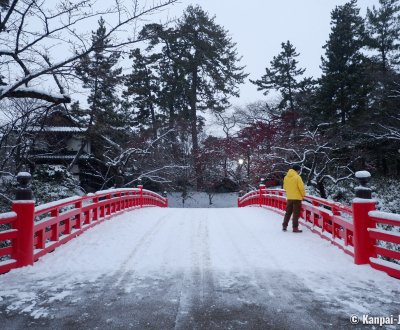Hirosaki
Cherry Trees Castle-Town In Aomori
Hirosaki is a small Japanese town located in Aomori prefecture’s central-west side, in the north of Japan. This ancient feudal city is renowned for its castle surrounded by thousands of cherry trees blooming in April, as well as for the Neputa Matsuri, a remarkable summer night festival.
Hirosaki's keep has been moved slightly away from its initial location in the park in 2013 for renovation works on its foundation that are expected to end in 2025. In the meantime, the indoor exhibition remains open to the public.
Hirosaki was founded during the Heian Period (794 – 1185), and became a fortified city in the early Edo period (1603 – 1868) in 1611 when the Tsugaru Clan built its castle 🏯 Hirosaki-jo. The original 5-stories keep burnt down in 1627 and was not reconstructed before 1810. The current days’ building has 3 floors open to the visit from spring to autumn. In winter, most of the indoor touristic places are closed due to the abundant snow falls.
The castle is standing in a well-maintained and pleasant historical park, and includes the following fortified constructions:
- Yagura turrets and tall enclosure walls overlooking moats;
- Beautiful vermilion bridges to cross the moats; and,
- 5 gates guarding the access to the keep.

Flowered moats from April to the Golden Week
The walk in the castle’s park is interesting all year long, with a touristic peak during the late blooming season of its 2,000 cherry trees: from mid-April to early May. Depending on the weather conditions and the year, this period overlaps the beginning of Japan’s national holidays, attracting a large number of visitors: about 2 million people gather over a few days in this small town.
Hirosaki is indeed known as one of the most beautiful sakura 🌸 spots in the Tohoku, like Kakunodate, another fortified town in the neighboring Akita prefecture. Autumn is also a beautiful, less crowded season to admire the Japanese cherry and maple trees' foliage change colors. The koyo 🍁 night illumination are wonderful. In January, the castle’s park is also lit-up with lanterns 🏮 at nightfall for the Snow Festival, a kind of winter matsuri that is staged in Hokkaido or in Japan’s mountain areas such as Yunishigawa Onsen ♨️ in the north of Nikko.
Additionally, the south of the park is home to 2 traditional gardens:
- Hirosaki Castle’s Botanical Garden, divided in 23 smaller areas with a display of 1,500 types of trees and plants; and,
- Fujita Memorial Garden, at the south-western entrance of the park, a remarkable Japanese garden created for a former private residence.

Cultural aspects: Samurai and Neputa Matsuri
The facilities located to the north of the castle’s park are more culture-oriented. Hirosaki’s former samurai district is preserved in a few streets, some of which have retained authenticity with cobbled roads lined with beautiful wooden constructions and beautiful trees. Overall, 4 former warriors and merchants’ residences, belonging to the Ito, Umeda, Ishiba and Iwata families are opened to the public.
We recommend discovering of the nearby Tsugaru-han Neputa Village, a museum dedicated to the city’s great festival, the Neputa Matsuri that takes place in early August every year. The night parade of illuminated floats is magnificent and reminds of Aomori City’s Nebuta Matsuri.
Tsugaru-han Neputa Village displays some of the floats, that are massive drawn and painted paper structures, such as giant fans illustrating various popular scenes of Japanese myths. The many lights placed inside the floats give them marvelous shapes and bring out their colorfulness in the dark exhibition room.
The museum is also a cultural center and brings together at the same place all the regional traditional knowledge. For example, musicians play the local version of the shamisen lute, the Tsugaru-jamisen. Several acts are performed every day at regular intervals.

Shopping streets between the castle and the station
Travelers who would like to stay overnight in Hirosaki can easily find a hotel 🏨 in the streets located between the JR station and the south of the Castle Park. For example, the Hirosaki Park Hotel has standard category rooms with a local Japanese dinner included. Moreover, its breakfast room offers a pleasant elevated view on the city.
We also recommend spending a little time trying one of the small cafés in town, especially the Dote no Coffee-ya Manchan. There you will enjoy home-made desserts, such as the apple pie, one of Hirosaki’s delicious specialties, along with local cider in a cozy atmosphere. The area is indeed one of the biggest apple producers of Japan. Apple picking directly from the apple orchard, especially at the Hirosaki Apple Park (弘前市りんご公園), is a very popular activity in a family trip.
Travelers exploring Aomori prefecture will find Hirosaki an easy and essential waypoint, to explore the memory of an idealized, yet elegant feudal Japan. Moreover, the city is overlooked by majestic Mount Iwaki, Aomori’s tallest mountain (1,625 meters high) and a sacred site the locals celebrate during the Oyama Sankei pilgrimage in early August.

